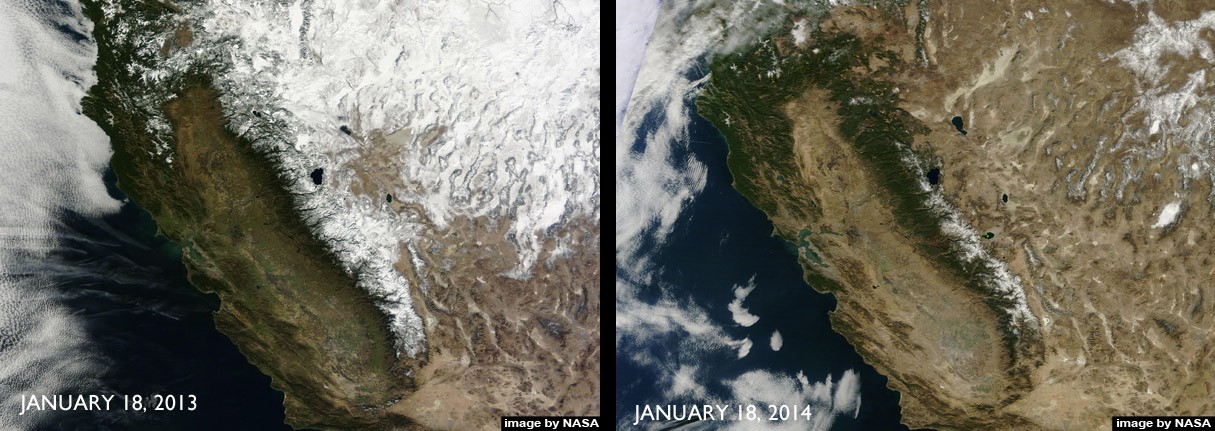The amount of beach days Southern California has seen this winter is unnerving. While the other side of the country has been inundated in ice storms and Polar Vortexes, we on the west have started saying “just another beautiful day!” with mounting anxiety. Waking up and immediately looking out the window, the sight of a cloudless blue sky incites a sense of dread. It’s because they now seem endless. We don’t even know what rain is anymore, and the likelihood of a California water crisis is foreseeable.
Here’s what Governor Jerry Brown had to say about the matter on January 17th this year: “I, Edmund G. Brown Jr., Governor of the State of California, in accordance with the authority vested in me by the state Constitution and statutes…HEREBY PROCLAIM A STATE OF EMERGENCY to exist in the state of California due to current drought conditions.”

As a result of all this, drinking water for many communities is at risk of contamination, farmer’s long-term investments are jeopardized and animals at risk of extinction are further threatened by a California water crisis. This is just naming a few of the issues that this lack of rainfall…precipitates (sorry, couldn’t resist).
The declaration of an official drought actually has more to do with water demand than the amount of rainfall. On the California Department of Water Resources’ website, they write: “Defining when drought occurs is a function of drought impacts to water users…Hydrologic conditions constituting a drought for water users in one location may not constitute a drought for water users in a different part of California.”
Typically, the first people to feel the effects of a drought are farmers and those in the agricultural industry. This is especially true in a California water crisis, where 80% of the state’s water is used for agricultural purposes, according to KCET.
But the current drought is extreme enough that it is felt beyond just the agricultural sector. 2013 was the driest calendar year in California since California was California (meaning 1850). USA Today cites the U.S. Drought Monitor in December 2013 as saying that 94.25% of the state is enduring some type of drought condition. The weather station in downtown Los Angeles received 3.6 inches of rain last year, while the average yearly rainfall for the city is 14.91 inches. This average is based on data reaching back to 1877.
What is causing this sever lack of rainfall? Most literally, it is that a high-pressure zone above California that would normally move south during the winter season has stayed put. This zone has diverted storms moving across the Pacific Ocean north or south of where they would normally pass over, meaning that few storms actually make it into the mainland. Hence, there is no rain for us.
Whether the extremity of this drought is due to Global Warming or natural variability is a contested issue. According to a New York Times article from February 16th, President Obama cited what is happening in California as an example of the effects of human-borne climate change. But the article points out that there is no definitive evidence to support this claim. It does seem, however, that climate change has intensified the effects of the drought, with moisture evaporating more quickly due to higher-than-average temperatures.
More disconcerting is the word that has been floating around reports of California’s dry-spell, the specter of climatology. This word is “mega-drought.” Paleoclimatologist Lynn Ingram from UC Berkeley, who studies climate going back thousands of years, says that data shows historical droughts that lasted years, decades, and even centuries. Furthermore, the 20th century was an abnormally wet 100 years for California. Much of the states infrastructure was built taking this amount of rainfall for granted. Ingram comments: “The late 1930s to the early 1950s were when a lot of our dams and aqueducts were built, and those were wetter decades. I think there’s an assumption that we’ll go back to that, and that’s not necessarily the case. We might be heading into a drier period now.” There is no clear indicator as to when the drought may end.
Combating drought is so difficult because unlike other emergencies, it happens very gradually and slowly. Appropriate response requires not only immediate solutions but also foresight. President Obama has already pledged $183 million to drought relief programs in California, according to the New York Times. The money will hopefully help farmers acquire water from other sources and keep their crops alive in spite of dry conditions.

- Only put full loads in the washing machine, reducing the amount of times you run it
- Don’t let the sink run while you brush your teeth
- Take shorter showers and take showers instead of baths
- Grow native plants in your garden that don’t require as much water
These and other minor changes around your home can literally help save hundreds of gallons per day. According to the Save Our Water campaign, the average Californian uses about 192 gallons of water every day. Check out their suggestions for more simple ways you can cut down your own water consumption.
California Water Crisis Prevention
Ultimately, the severity of this crisis in the future will depend upon the path of nature. The best we can do as a community of Californians is make the water we do have last as long as it can. This up to every last one of us. Being conscious of one’s own water use takes a transition in thought, but it is a crucial one. We each play a part in how our resources are consumed. Reflecting on your own habits is the first step to community conservation.
It’s hot out there. Drink plenty of water. Just don’t pour it over your head trying to emulate a Coca-Cola commercial.



